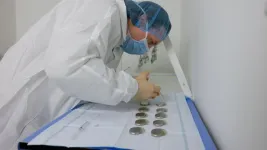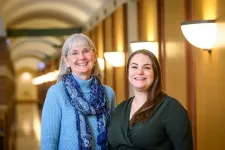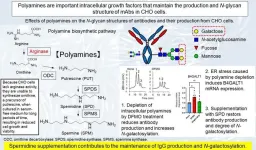(Press-News.org) Cambridge, Mass., Jan. 16, 2024 - A team of researchers from the ADA Forsyth Institute and University of North Carolina (UNC), Chapel Hill used single-cell transcriptomic analysis to successfully map dental pulp stem cells (DPSC) and periodontal ligament stem cells (PDLSC) and found remarkable differences between them. The study, which appeared in the Journal of Dental Research, provides the most detailed analysis of these stem cells to date, identifying the entire genome of the stem cells and their potential differentiation trajectories.
“Dental pulp and periodontal ligament stem cells both have the potential to develop into any type of cell in the body,” explained ADA Forsyth Scientist, Alpdogan Kantarci, DDS, MSc, PhD who led the study with UNC biostatistician, Di Wu, PhD. “We wanted to discover how they were different and whether there were differences in their capacity to differentiate into other cell types.”
The team discovered that both types of stem cells have seven different gene clusters, with different categories of genes reflecting different stages in the process of differentiation. Four of those gene clusters were similar when comparing the two types of stem cells. Three of the clusters were uniquely different. While PDLSC’s were more like fibroblasts (cells that can become connective tissue) because of an increased proportion of certain clusters, DPSCs had higher differentiation potential and converted more easily into bone cells.
“This new information on the specific genetic composition and mechanisms of differentiation in dental pulp and periodontal ligament stem cells will generate a new era of work in regenerative medicine” said Dr. Kantarci. “We could potentially select a stem cell based on its distinct properties to create targeted regenerative dental tissue repair and other regenerative therapies.”
ADA Forsyth scientists obtained the stem cells from extracted teeth without culturing them (unlike other studies of these stem cells) and sent them unfrozen to UNC for single-cell transcriptomic analysis. Meanwhile, they also took the same cells and differentiated them into known cell types such as fibroblasts (cells that can become connective tissue) and osteoblasts (bone cells). The team then used advanced bioinformatics to compare and document the capacity of the two populations of stem cells to differentiate into osteoblasts or fibroblasts. The results of the bulk RNA sequencing validated the findings of the single-cell transcriptomics.
“Prior to this study, people believed that stem cells were either very similar to each other, or very different from one another,” said Dr. Kantarci. “Now we have enough information to see the huge potential for using specific features of these stem cells to create more effective and targeted regenerative therapies.”
Additional collaborators on the project included T. Van Dyke, H. Hasturk, and Y.C. Wu of ADA Forsyth; Y. Yang, T. Alvarez, M.Z. Miao and G. Li of UNC Chapel Hill; and, J. Lou of University of Washington, Seattle.
Funding:
This work was funded by NIH/NIA (AG062496) and NIH/NIDCR (DE025020) grants, and the University of North Carolina Computation Medicine Program Award 2020. T. Alves holds a J. William Fulbright Scholarship (CAPES—finance code 001). M.Z. Miao is supported by the Intramural Research Program of the National Institutes of Health, National Institute of Dental and Craniofacial Research ZIA DE000719 and ZIE DE000727.
Paper cited:
“Single-Cell Transcriptomic Analysis of Dental Pulp and Periodontal Ligament Stem Cells,” Journal of Dental Research. DOI: 10.1177/00220345231205283
###
About the ADA Forsyth Institute
The ADA Forsyth Institute was founded in 1910 as the Forsyth Dental Infirmary for Children (later, the Forsyth Institute), to provide dental care to the disadvantaged children of Boston. While continuing to serve children in need, yet recognizing the ultimate goal is to prevent dental disease, the Institute in 1915 began to focus on scientific research and is today the world’s leader in oral health research. In October of 2023, the Institute joined with the American Dental Association to form the ADA Forsyth Institute, a 501(c)(3) entity dedicated to improving people’s oral and overall health and powering the profession of dentistry through cutting-edge basic research, creative translational science, innovative clinical technologies, and global public health outreach. Consistent with the Institute’s founding mission, the ADA ForsythKids mobile dental program continues to serve children in need.
About the American Dental Association
The not-for-profit ADA is the nation's largest dental association, representing 159,000 dentist members. The premier source of oral health information, the ADA has advocated for the public's health and promoted the art and science of dentistry since 1859. The ADA's state-of-the-art research facilities develop and test dental products and materials that have advanced the practice of dentistry and made the patient experience more positive. The ADA Seal of Acceptance long has been a valuable and respected guide to consumer dental care products. The Journal of the American Dental Association (JADA), published monthly, is the ADA's flagship publication and the best-read scientific journal in dentistry. For more information about the ADA, visit ADA.org. For more information on oral health, including prevention, care and treatment of dental disease, visit the ADA's consumer website MouthHealthy.org.
END
Neuroscientists from the University of Vienna and the Karolinska Institute in Stockholm have investigated whether playing violent video games leads to a reduction in human empathy. To do this, they had adult test subjects play a violent video game repeatedly over the course of an experiment lasting several weeks. Before and after, their empathic responses to the pain of another person were measured. It was found that the violent video game had no discernible effect on empathy and underlying brain activity. These results have now been published in the renowned journal eLife.
Video games have become an integral part of the everyday life of many ...
WASHINGTON (Jan. 16, 2024) – Artificial intelligence (AI) has the potential to detect rheumatic heart disease (RHD) with the same accuracy as a cardiologist, according to new research demonstrating how sophisticated deep learning technology can be applied to this disease of inequity. The work could prevent hundreds of thousands of unnecessary deaths around the world annually.
Developed at Children’s National Hospital and detailed in the latest edition of the Journal of the American Heart Association, the new AI system combines the power of novel ultrasound probes with portable electronic ...
Knowing a patient’s weight is necessary for many weight-based medications such as thrombolytics, anticoagulants and numerous cardiovascular medications. Scaling drugs to a patient’s weight prevents adverse events from overtreatment and treatment failure due to underdosing. Inaccurate weight estimations may lead to inaccurate drug doses, which could cause patient harm.
However, in the emergency department (ED) during resuscitative care, measuring weight is often impossible. Moreover, little is known about the relative accuracy of different methods currently used to weigh patients during emergency care. For example, ...
TORONTO (16 January 2024) – As part of its pioneering approach to drug discovery, the Canadian nonprofit Conscience announced today that its first open science competition has resulted in the identification of seven promising molecules, or “hits,” that show potential for new, more effective drugs for familial Parkinson’s disease.
This first competition in Conscience’s CACHE (Critical Assessment of Computational Hit-Finding Experiments) Challenge series was funded by The ...
From inside an operating room in Barquisimeto, Venezuela, electrophysiologist Maria Milagros Arends, M.D., threads wires from a pacemaker through the veins and into the heart muscle of a patient.
This pacemaker, which regulates the heartbeat and can be lifesaving, was once in the body of another person. It has been recycled, or “reconditioned”— donated, tested, sterilized and shipped from the United States to the South American country for implantation.
“We have a waiting list of around 300 people who could potentially lose their lives in less than a month,” ...
CHAMPAIGN, Ill. — A new study links increased use of acetaminophen during pregnancy – particularly in the second trimester – to modest but noticeable increases in problems with attention and behavior in 2-, 3- and 4-year-olds. The study adds to a growing body of evidence linking the frequent use of acetaminophen in pregnancy to developmental problems in offspring.
The findings are detailed in the journal Neurotoxicology and Teratology.
The research is part of the Illinois Kids Development Study at the University of Illinois Urbana-Champaign, which explores how environmental ...
Monoclonal antibodies (mAbs) are laboratory-designed proteins that mimic the immune system's antibodies. To date, many therapeutic mAbs belonging to the immunoglobulin G (IgG) class of antibodies, have been approved for the treatment of cancer and autoimmune diseases. Cell lines such as the Chinese hamster ovary (CHO) cells are generally used to produce mAbs. Notably, the production and manufacture of mAbs are regulated by critical quality attributes (CQAs) to ensure their safety and efficacy in treatment.
An important CQA for mAbs is the N-linked glycosylation present at a specific position (Asn297). N-linked glycans consist of N-acetylglucosamine (GlcNAc), mannose (Man), fucose ...
DALLAS, JANUARY 16, 2024 — A patient’s oral health can be an indicator of overall health and well-being. Research shows that chronic gum inflammation may be associated with other chronic diseases including coronary artery disease and diabetes.[1] In addition, certain bacteria that live in the mouth can travel through the bloodstream to other parts of the body, including the heart and lungs. Oral bacteria, including viridans group streptococcal (VGS), can cause infective endocarditis, an infection of the inner ...
PULLMAN, Wash. – While it is well known that cannabis can cause the munchies, researchers have now revealed a mechanism in the brain that promotes appetite in a set of animal studies at Washington State University.
The discovery, detailed in the journal Scientific Reports, could pave the way for refined therapeutics to treat appetite disorders faced by cancer patients as well as anorexia and potentially obesity.
After exposing mice to vaporized cannabis sativa, researchers used calcium imaging technology, which is similar to a brain MRI, to determine how their brain cells responded. They observed that cannabis activated a set of cells in the hypothalamus when the rodents anticipated ...
Osaka, Japan – Imagine stoplights and cars communicating with each other to optimize the flow of traffic. This isn’t science fiction – it’s the Internet of Things (IoT), i.e., objects that sense their surroundings and respond via the internet. As the global population rises and such technologies continue to develop, you might wonder – what will power this digital world of tomorrow?
Wind, solar, yes. Something all around us might not immediately come to mind though – heat. Now, in a study recently published in Nature Communications, a multi-institutional research team including Osaka University has unveiled a ...





